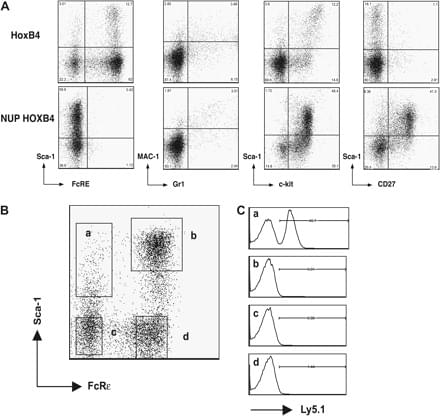The new Pew Research Center report found a surge of adults leaving Christianity to become atheist, agnostic, or “nothing in particular.”
CAR-T immune therapies were developed to fight cancer. The same technique just showed promise treating lupus, but it costs hundreds of thousands.
Circa 2008 face_with_colon_three
Adult bone marrow (BM) houses a tiny pool of hematopoietic stem cells (HSCs) that have the ability to maintain not only themselves but also all the rest of highly turning over blood lineages throughout the mammalian life (1, 2). Hence, the ability to sustain HSC in tissue culture would allow serial introduction of gain or loss of function mutations efficiently in hematopoietic system. However, our failure to expand HSC in culture has hampered the use of this approach. In fact, BM suspension cultures lose rapidly their HSC content despite vigorous growth of progenitors and more differentiated cells at least for 3 weeks even in optimal cytokine milieu (3, 4). Therefore, the phenomenon of stem cell exhaustion or senescence may set the limits that make it impossible even in principle to expand HSC in culture for longer periods (5–7).
Mouse HSC do expand in vivo (8, 9), at least up to 8000-fold, as shown by Iscove and Nawa (9) through serial transplantation experiments that assessed carefully the input and output contents of HSC in each transfer generation. Recently also in vitro approaches have been improved and refined culture conditions with new growth factors can now support up to 30-fold expansion of mouse HSC ex vivo (10). However, since it is not clear to what extent external culture conditions can be improved, alternative but not mutually exclusive efforts to change the intrinsic properties of HSC have been taken. Seminal experiments in this respect by Humphries, Savageau and their colleagues have shown that ectopic expression of HOXB4 transcription factor in BM cells support the survival and expansion of HSC in vivo and importantly also in vitro (11–13). By rigorously monitoring the HSC content in their cultures of HOXB4-transduced BM cells, they found that HSC could be expanded up to 41-fold in the 2-week liquid cultures (13). HOXB4 belongs to a large family of HOX transcription factors that are crucial for the basic developmental processes in addition to their role in maintenance of different stem cell compartments.
Capitalizing on the findings of Humphries, Savageau and their colleagues, we have established long-term murine BM cultures of HOXB4-transduced cells (HOX cells) and monitored their stem cell content to find out how extensively genetically modified HSC and their multipotent primitive progenitors (MPPs) can be expanded in culture for experimental purposes. In addition and for comparison, we established BM cultures transduced with constructs encoding for Nucleoporin 98 (NUP)–HOXB4 (NUP cells) fusion protein again following the lead of Humphries et al. (14) who showed that ectopic expression of similar fusions promoted in vivo even more robust expansion and survival of HSC.
Summary: Study reveals how reward enhances connectivity between the ventral striatum and the default mode network, impacting behavior.
Source: Kessler Foundation.
Researchers have reported findings that add to our knowledge of how human behavior may be shaped by the default mode network, a specific network of brain regions with both resting and task-related states.
A phenomenon that often accompanies technological innovations involves how they tend to become smaller with their improvement over time. From televisions and communication devices like telephones to computers and microchip components, many of the technologies we use every day occupy a fraction of the space in our homes and offices that their predecessors did just decades ago.
In keeping with this trend, it is no surprise that a new tech developed by scientists at Sandia National Laboratories, in cooperation with the Max Planck Institute for the Science of Light, may soon replace cumbersome technologies than once required an entire room to operate, thanks to an ultrathin invention that could change the future of computation, encryption, and a host of other technologies.
At the heart of the invention and its function is a peculiar phenomenon that has perplexed physicists for decades, known as quantum entanglement.
We all start from a single cell, the fertilized egg. From this cell, through a process involving cell division, cell differentiation and cell death a human being takes shape, ultimately made up of over 37 trillion cells across hundreds or thousands of different cell types.
While we broadly understand many aspects of this developmental process, we do not know many of the details.
A better understanding of how a fertilized egg turns into trillions of cells to form a human is primarily a mathematical challenge. What we need are mathematical models that can predict and show what happens.
Chardan hosted its 4th Annual Chardan Genetic Medicines Conference in October 2020, featuring over 80 public and private companies representing in vivo gene therapy, ex vivo gene therapy, gene editing, RNA medicines, and other subsegments of the genetic medicines space. Among our various panels with preeminent thought leaders, we spoke with newly-minted Nobel laureate, President of the Innovative Genomics Institute, and Professor of Molecular and Cell Biology and Chemistry at UC Berkeley, Jennifer Doudna.
PhD about open questions and areas of innovation in the CRISPR gene editing space.
The U.S.-based facility hopes to capture CO2, roughly the equivalent of 5 million return flights between London and New York annually.
A U.S. climate tech company has developed a project that could remove millions of tonnes of carbon dioxide from the atmosphere annually.
CarbonCapture Inc. has revealed plans for the largest carbon capture facility in the world in Wyoming, in an exclusive partnership with premier carbon storage company Frontier Carbon Solutions, according to a press release published by Business Wire last week.
Artificial gravity is the new black.
Vast, a California-based startup, has revealed that the company will develop artificial-gravity space stations to enhance human productivity in space. With a team of exceptional engineers, industry experts, k and an aerospace engineer and former vice president at SpaceX, Hans Koenigsmann, the company aims to create a setting where people can live as well as work in space.
The solar system has an incredible amount of resources.
3DSculptor/iStock.
Vast’s mission is to enable a future where millions of people are living across the solar system, said Jed McCaleb, who worked on projects such as Stellar, the Astera Institute, Ripple, and eDonkey2000.
Dylan Field and Evan Wallace started building design startup Figma to challenge Adobe’s PhotoShop. Now Adobe has made them billionaires after announcing it would acquire Figma for $20 billion in a cash and shares deal.
The deal doubles the valuation that the San Francisco-based startup landed in June 2021, when it raised $200 million from investors including Durable Capital and Morgan Stanley. Forbes.
Figma has been branded the Google Docs, or GitHub, for designers with a loyal user base in the millions paying between $12 or $45 per editor for its digital whiteboard product.
The deal values Figma cofounders Dylan Field and Evan Wallace’s stakes in the buzzy design startup at $2 billion apiece.









